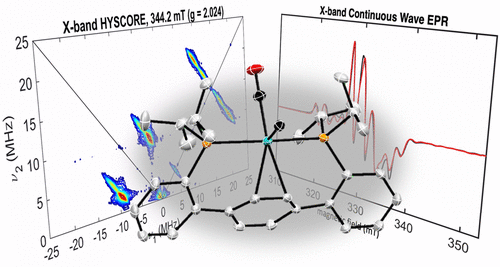当前位置:
X-MOL 学术
›
J. Am. Chem. Soc.
›
论文详情
Our official English website, www.x-mol.net, welcomes your
feedback! (Note: you will need to create a separate account there.)
Terminal, Open-Shell Mo Carbide and Carbyne Complexes: Spin Delocalization and Ligand Noninnocence
Journal of the American Chemical Society ( IF 14.4 ) Pub Date : 2021-08-11 , DOI: 10.1021/jacs.1c03806 Gwendolyn A Bailey 1 , Joshua A Buss 1 , Paul H Oyala 1 , Theodor Agapie 1
Journal of the American Chemical Society ( IF 14.4 ) Pub Date : 2021-08-11 , DOI: 10.1021/jacs.1c03806 Gwendolyn A Bailey 1 , Joshua A Buss 1 , Paul H Oyala 1 , Theodor Agapie 1
Affiliation

|
Open-shell compounds bearing metal–carbon triple bonds, such as carbides and carbynes, are of significant interest as plausible intermediates in the reductive catenation of C1 oxygenates. Despite the abundance of closed-shell carbynes reported, open-shell variants are very limited, and an open-shell carbide has yet to be reported. Herein, we report the synthesis of the first terminal, open-shell carbide complexes, [K][1] and [1][BArF4] (1 = P2Mo(≡C:)(CO), P2 = a terphenyl diphosphine ligand), which differ by two redox states, as well as a series of related open-shell carbyne complexes. The complexes are characterized by single-crystal X-ray diffraction and NMR, EPR, and IR spectroscopies, while the electronic structures are probed by EPR studies and DFT calculations to assess spin delocalization. In the d1 complexes, the spin is primarily localized on the metal (∼55–77% Mo dxy) with delocalization on the triply bonded carbon of ∼0.05–0.09 e–. In the reduced carbide [K][1], a direct metal–arene interaction enables ancillary ligand reduction, resulting in reduced radical character on the terminal carbide (⩽0.02 e–). Reactivity studies with [K][1] reveal the formation of mixed-valent C–C coupled products at −40 °C, illustrating how productive reactivity manifolds can be engendered through the manipulation of redox states. Combined, the results inform on the electronic structure and reactivity of a new and underrepresented class of compounds with potential significance to a wide array of reactions involving open-shell species.
中文翻译:

末端、开壳钼碳化物和卡宾配合物:自旋离域化和配体非纯洁性
带有金属-碳三键的开壳化合物,如碳化物和卡宾,作为 C 1含氧化合物还原链中的合理中间体具有重要意义。尽管报道了大量的闭壳卡宾,但开壳的变体非常有限,而且开壳的碳化物尚未报道。在此,我们报告了第一个末端开壳碳化物复合物[K][1]和[1][BAr F 4 ] ( 1= P2Mo(≡C:)(CO),P2 = 三联苯二膦配体),它们的区别在于两种氧化还原状态,以及一系列相关的开壳碳炔配合物。这些配合物的特征在于单晶 X 射线衍射和 NMR、EPR 和 IR 光谱,而电子结构则通过 EPR 研究和 DFT 计算进行探测,以评估自旋离域。在 d 1配合物中,自旋主要位于金属上(~55-77% Mo d xy),在~0.05-0.09 e -的三键碳上离域。在还原的碳化物[K][1] 中,金属-芳烃的直接相互作用使辅助配体还原,导致末端碳化物(⩽0.02 e -)上的自由基特征降低。反应性研究[K][1]揭示了在 -40 °C 下混合价 C-C 耦合产物的形成,说明了如何通过操纵氧化还原状态产生生产性反应流形。综合起来,这些结果揭示了一类新的和代表性不足的化合物的电子结构和反应性,这些化合物对涉及开壳物质的各种反应具有潜在意义。
更新日期:2021-08-25
中文翻译:

末端、开壳钼碳化物和卡宾配合物:自旋离域化和配体非纯洁性
带有金属-碳三键的开壳化合物,如碳化物和卡宾,作为 C 1含氧化合物还原链中的合理中间体具有重要意义。尽管报道了大量的闭壳卡宾,但开壳的变体非常有限,而且开壳的碳化物尚未报道。在此,我们报告了第一个末端开壳碳化物复合物[K][1]和[1][BAr F 4 ] ( 1= P2Mo(≡C:)(CO),P2 = 三联苯二膦配体),它们的区别在于两种氧化还原状态,以及一系列相关的开壳碳炔配合物。这些配合物的特征在于单晶 X 射线衍射和 NMR、EPR 和 IR 光谱,而电子结构则通过 EPR 研究和 DFT 计算进行探测,以评估自旋离域。在 d 1配合物中,自旋主要位于金属上(~55-77% Mo d xy),在~0.05-0.09 e -的三键碳上离域。在还原的碳化物[K][1] 中,金属-芳烃的直接相互作用使辅助配体还原,导致末端碳化物(⩽0.02 e -)上的自由基特征降低。反应性研究[K][1]揭示了在 -40 °C 下混合价 C-C 耦合产物的形成,说明了如何通过操纵氧化还原状态产生生产性反应流形。综合起来,这些结果揭示了一类新的和代表性不足的化合物的电子结构和反应性,这些化合物对涉及开壳物质的各种反应具有潜在意义。





















































 京公网安备 11010802027423号
京公网安备 11010802027423号